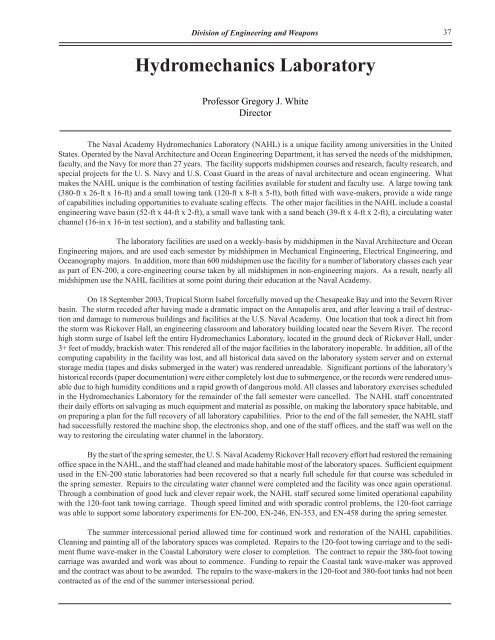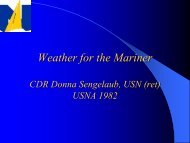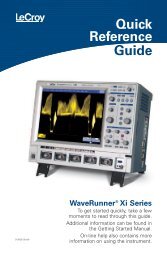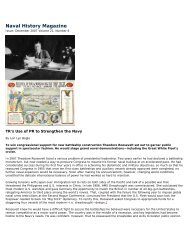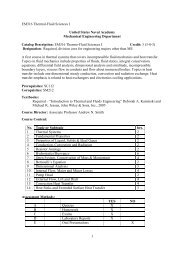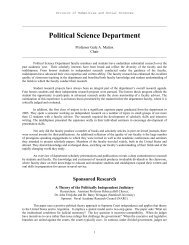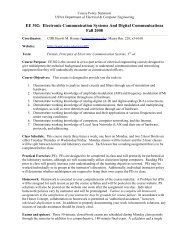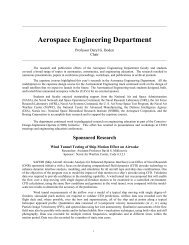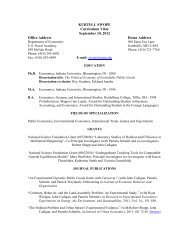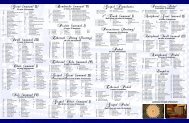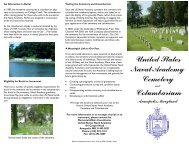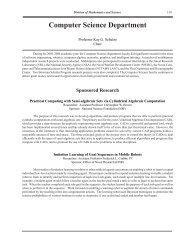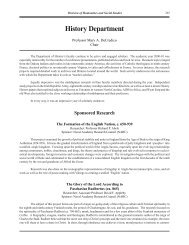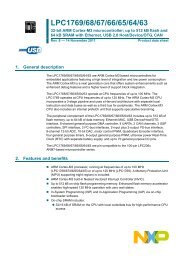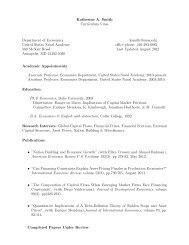Hydromechanics Laboratory - United States Naval Academy
Hydromechanics Laboratory - United States Naval Academy
Hydromechanics Laboratory - United States Naval Academy
You also want an ePaper? Increase the reach of your titles
YUMPU automatically turns print PDFs into web optimized ePapers that Google loves.
Division of Engineering and Weapons<br />
37<br />
<strong>Hydromechanics</strong> <strong>Laboratory</strong><br />
Professor Gregory J. White<br />
Director<br />
The <strong>Naval</strong> <strong>Academy</strong> <strong>Hydromechanics</strong> <strong>Laboratory</strong> (NAHL) is a unique facility among universities in the <strong>United</strong><br />
<strong>States</strong>. Operated by the <strong>Naval</strong> Architecture and Ocean Engineering Department, it has served the needs of the midshipmen,<br />
faculty, and the Navy for more than 27 years. The facility supports midshipmen courses and research, faculty research, and<br />
special projects for the U. S. Navy and U.S. Coast Guard in the areas of naval architecture and ocean engineering. What<br />
makes the NAHL unique is the combination of testing facilities available for student and faculty use. A large towing tank<br />
(380-ft x 26-ft x 16-ft) and a small towing tank (120-ft x 8-ft x 5-ft), both fitted with wave-makers, provide a wide range<br />
of capabilities including opportunities to evaluate scaling effects. The other major facilities in the NAHL include a coastal<br />
engineering wave basin (52-ft x 44-ft x 2-ft), a small wave tank with a sand beach (39-ft x 4-ft x 2-ft), a circulating water<br />
channel (16-in x 16-in test section), and a stability and ballasting tank.<br />
The laboratory facilities are used on a weekly-basis by midshipmen in the <strong>Naval</strong> Architecture and Ocean<br />
Engineering majors, and are used each semester by midshipmen in Mechanical Engineering, Electrical Engineering, and<br />
Oceanography majors. In addition, more than 600 midshipmen use the facility for a number of laboratory classes each year<br />
as part of EN-200, a core-engineering course taken by all midshipmen in non-engineering majors. As a result, nearly all<br />
midshipmen use the NAHL facilities at some point during their education at the <strong>Naval</strong> <strong>Academy</strong>.<br />
On 18 September 2003, Tropical Storm Isabel forcefully moved up the Chesapeake Bay and into the Severn River<br />
basin. The storm receded after having made a dramatic impact on the Annapolis area, and after leaving a trail of destruction<br />
and damage to numerous buildings and facilities at the U.S. <strong>Naval</strong> <strong>Academy</strong>. One location that took a direct hit from<br />
the storm was Rickover Hall, an engineering classroom and laboratory building located near the Severn River. The record<br />
high storm surge of Isabel left the entire <strong>Hydromechanics</strong> <strong>Laboratory</strong>, located in the ground deck of Rickover Hall, under<br />
3+ feet of muddy, brackish water. This rendered all of the major facilities in the laboratory inoperable. In addition, all of the<br />
computing capability in the facility was lost, and all historical data saved on the laboratory system server and on external<br />
storage media (tapes and disks submerged in the water) was rendered unreadable. Significant portions of the laboratory’s<br />
historical records (paper documentation) were either completely lost due to submergence, or the records were rendered unusable<br />
due to high humidity conditions and a rapid growth of dangerous mold. All classes and laboratory exercises scheduled<br />
in the <strong>Hydromechanics</strong> <strong>Laboratory</strong> for the remainder of the fall semester were cancelled. The NAHL staff concentrated<br />
their daily efforts on salvaging as much equipment and material as possible, on making the laboratory space habitable, and<br />
on preparing a plan for the full recovery of all laboratory capabilities. Prior to the end of the fall semester, the NAHL staff<br />
had successfully restored the machine shop, the electronics shop, and one of the staff offices, and the staff was well on the<br />
way to restoring the circulating water channel in the laboratory.<br />
By the start of the spring semester, the U. S. <strong>Naval</strong> <strong>Academy</strong> Rickover Hall recovery effort had restored the remaining<br />
office space in the NAHL, and the staff had cleaned and made habitable most of the laboratory spaces. Sufficient equipment<br />
used in the EN-200 static laboratories had been recovered so that a nearly full schedule for that course was scheduled in<br />
the spring semester. Repairs to the circulating water channel were completed and the facility was once again operational.<br />
Through a combination of good luck and clever repair work, the NAHL staff secured some limited operational capability<br />
with the 120-foot tank towing carriage. Though speed limited and with sporadic control problems, the 120-foot carriage<br />
was able to support some laboratory experiments for EN-200, EN-246, EN-353, and EN-458 during the spring semester.<br />
The summer intercessional period allowed time for continued work and restoration of the NAHL capabilities.<br />
Cleaning and painting all of the laboratory spaces was completed. Repairs to the 120-foot towing carriage and to the sediment<br />
flume wave-maker in the Coastal <strong>Laboratory</strong> were closer to completion. The contract to repair the 380-foot towing<br />
carriage was awarded and work was about to commence. Funding to repair the Coastal tank wave-maker was approved<br />
and the contract was about to be awarded. The repairs to the wave-makers in the 120-foot and 380-foot tanks had not been<br />
contracted as of the end of the summer intersessional period.
38 <strong>Hydromechanics</strong> <strong>Laboratory</strong><br />
During any normal year, the NAHL facilities are used by midshipmen, faculty, and NAHL staff for both fundamental<br />
and applied research. Prior to the arrival of Tropical Storm Isabel, several research programs were conducted in<br />
the laboratory:<br />
• Planar Motion Mechanism (PMM) testing in support of Permanent Military Professor (PMP)-designate<br />
Navy Commander Jeffrey W. Stettler’s Massachusetts Institute of Technology (MIT) doctoral dissertation<br />
• The Effect of Surface Roughness on Hydrodynamic Drag and Turbulence<br />
• Comparison of the Hydrodynamic Performance of Fouling-Release Surfaces with Copper-Based Antifouling<br />
Coatings<br />
• Development of Design Guidelines for Timber Wave Screens<br />
• Comparative Analysis of Submarine Sail Configurations – Phase I. (Unfortunately, the tropical storm<br />
arrived before the third and final phases were conducted. As a result, the project was placed on hold pending<br />
the restoration of the 380-foot towing tank.)<br />
Despite not having working facilities after the storm, the NAHL staff was able to support some research efforts,<br />
thus allowing for some limited student and faculty research to continue:<br />
• Mooring Forces Induced by Passing Ships<br />
• Cooperative Research by the Webb Institute and the U.S. <strong>Naval</strong> <strong>Academy</strong>: Cooperative Scale Effects<br />
Study<br />
• Determining Dynamic Lift Coefficients for High Aspect Ratio Control Surfaces (This Trident Scholar<br />
project was originally planned for the 380-foot towing tank. Because of the damage to the tank, the project was<br />
moved to <strong>Naval</strong> Surface Warfare Center (NSWC) – Carderock Dvision. All test equipment and experimental<br />
setups were performed at the <strong>Naval</strong> <strong>Academy</strong>’s <strong>Hydromechanics</strong> <strong>Laboratory</strong>, with the assistance of NAHL<br />
staff. <strong>Naval</strong> <strong>Academy</strong> faculty, the Trident Scholar and staff from the NAHL performed the actual testing at<br />
NSWC-Carderock.)<br />
The <strong>Naval</strong> <strong>Academy</strong> <strong>Hydromechanics</strong> <strong>Laboratory</strong> is operated and maintained by a multi-talented staff, which includes<br />
three engineers/naval architects, two engineering technicians, and an office manager/secretary. Supporting laboratory<br />
efforts are the shop and model-making facilities in the Technical Support Department. The laboratory is further supported<br />
by a Memoranda of Understanding (MOU) with the <strong>Naval</strong> Station-Annapolis, providing support of diving operations in<br />
the laboratory.<br />
The results of laboratory research efforts are reflected in journal articles written by faculty and laboratory staff<br />
members and in presentations at technical symposia. The <strong>Laboratory</strong> is actively represented in the International Towing<br />
Tank Conference (ITTC) and staff members are active participants in the Society of <strong>Naval</strong> Architects and Marine Engineers<br />
(SNAME), the American Society of <strong>Naval</strong> Engineers (ASNE), the Chesapeake Sailing Yacht Symposium (CSYS),<br />
the American Towing Tank Conference (ATTC), and the Coasts, Oceans, Ports and Rivers Institute (COPRI) of the<br />
American Society of Civil Engineers (ASCE). The diverse interests of these organizations reflect the broad nature of the<br />
<strong>Hydromechanics</strong> <strong>Laboratory</strong>'s activities.
<strong>Hydromechanics</strong> <strong>Laboratory</strong><br />
39<br />
Sponsored Research<br />
Development of Design Guidelines for Timber Wave Screens<br />
Researcher: Professor David L. Kriebel, P.E.<br />
Sponsor: U. S. Coast Guard Civil Engineering Unit Providence<br />
The U. S. Coast Guard maintains numerous boat launches, piers, and floating docks that are used by small searchand-rescue<br />
vessels. A common problem is the lack of protection from wave attack. In many cases, the facilities are small and<br />
large breakwaters are not economically feasible. As a result, wave protection is provided by small low-cost vertical timber<br />
wave screens, also called wave barriers or wave fences. Research efforts at the <strong>Naval</strong> <strong>Academy</strong> include: (1) selected physical<br />
model tests on typical wave screens configurations, (2) development of a predictive model to assess wave transmission<br />
past wave screens and wave forces on wave screens, and (3) development of general design guidelines to be used by the<br />
Coast Guard in future repair or new construction of timber wave screens.<br />
Mooring Forces Induced by Passing Ships<br />
Researcher: Professor David L. Kriebel, P.E.<br />
Sponsor: <strong>Naval</strong> Facilities Engineering Service Center (NAVFAC)<br />
The Navy has recently been experiencing damages to moored ships and piers as a result of excessive motions of<br />
the moored vessel caused by passing ship traffic. Many Navy piers are located alongside commercial navigation channels<br />
where commercial vessels enter/exit port at a high rate of speed. The waves generated by these vessels may then induce large<br />
surge, sway, or yaw motions of any vessels moored at the pier. In order to better understand this problem, a series of physical<br />
model tests are being conducted in the <strong>Hydromechanics</strong> <strong>Laboratory</strong>. In these tests, one ship model will be moored using load<br />
cells while another ship model will be towed past at various speeds and separation distances. Data have been analyzed to<br />
develop empirical guidelines on the surge force, sway forces, and yaw moments experienced acting on the moored vessel.<br />
The results have also been used to validate computer codes used by the <strong>Naval</strong> Facilities Engineering Service Center.<br />
Comparison of the Hydrodynamic Performance of Fouling-Release Surfaces<br />
with Copper-Based Antifouling Coatings<br />
Researcher: Assistant Professor Michael P. Schultz<br />
Sponsor: Office of <strong>Naval</strong> Research (ONR)<br />
The primary purpose of a ship antifouling system is to limit the increase in drag that will be incurred with fouling<br />
settlement on the hull. Ineffectiveness in this endeavor will lead to an increase in energy consumption and a platform that<br />
is unable to meet its mission. The introduction of non-toxic, fouling-release coating systems as alternatives to traditional<br />
biocide-based antifoulings has necessitated a change in philosophy with respect to these coatings. Since fouling-release<br />
coatings do not prevent settlement, various methods to quantify the tenacity of adhesion of organisms on these systems have<br />
been offered. Data from these tests are of particular interest because fouling-release surfaces that cannot “self clean” due<br />
to hydrodynamic forces or be mechanically cleaned without significant damage will likely suffer large drag penalties. For<br />
fouling-release coatings to serve as viable alternatives to traditional biocide-based systems, their hydrodynamic performance<br />
must compare favorably with traditional systems over the entire coating life cycle. To gain a better understanding of this,<br />
hydrodynamic testing of a range of fouling-release and antifouling coatings has been underway for two years. Models to<br />
account for drag increase due to fouling and coating deterioration, which are based on the surface roughness, have been<br />
developed and successfully implemented. Work is presently underway to refine these models and extend them to longer<br />
exposure periods.<br />
Comparative Analysis of Submarine Sail Configurations – Phase I<br />
Researcher: Professor Gregory J. White<br />
Sponsor: Office of <strong>Naval</strong> Intelligence (ONI)<br />
The <strong>Naval</strong> <strong>Academy</strong> <strong>Hydromechanics</strong> <strong>Laboratory</strong> (NAHL) undertook a submarine model testing program for the
40 <strong>Hydromechanics</strong> <strong>Laboratory</strong><br />
Office of <strong>Naval</strong> Intelligence (ONI). The testing program consisted of two phases. The first phase was a systematic series<br />
of tests on a generic submarine hull to establish a baseline for further testing. This phase included establishing the forces<br />
and flow characteristics on a bare hull and a bare hull with a baseline sail configuration. The second phase of the project<br />
involved having a midshipman perform a test series of the baseline hull with two different sail configurations. The plans<br />
for the sail configurations were provided by ONI and the model sails were made by the model makers of the Technical<br />
Support Division (TSD) of the U. S. <strong>Naval</strong> <strong>Academy</strong> Division of Engineering and Weapons.<br />
The <strong>Naval</strong> <strong>Academy</strong> <strong>Hydromechanics</strong> <strong>Laboratory</strong> set up and calibrated the <strong>Laboratory</strong>’s Sub-Off submarine model<br />
for a series of unclassified resistance tests in the <strong>Naval</strong> <strong>Academy</strong>’s 380-foot towing tank. Drag and lift forces were recorded<br />
for each test run. Flow visualization tests, utilizing yarn tufts, around and on the sails, were performed and recorded utilizing<br />
an underwater video camera.<br />
Unfortunately, during the early testing of the second phase, the <strong>Naval</strong> <strong>Academy</strong> facilities were extensively damaged<br />
by the flooding from Tropical Storm Isabel’s storm surge. The flooding destroyed the 380-foot tank carriage speed control<br />
system, such that the 380-foot tank carriage has been out-of-commission since the storm hit on 18 September 2003. Work<br />
on this project will resume at the first opportunity following repairs to the towing tank.<br />
Trident Scholar Project<br />
Determination of Dynamic Lift Coefficients for High Aspect Ratio Control Surfaces<br />
(Trident Report # 325)<br />
Researcher: Midshipman 1/C Jared R. Patton, USNR<br />
Advisers: Associate Professor Paul H. Miller, and Mr. John J. Zseleczky, <strong>Naval</strong> Architect, P.E.,<br />
and Mr. William E. Beaver, <strong>Naval</strong> Architect (U.S. <strong>Naval</strong> <strong>Academy</strong> <strong>Hydromechanics</strong> <strong>Laboratory</strong>)<br />
Sponsor: Office of <strong>Naval</strong> Research (ONR)<br />
The goal of this Trident Project was the determination of the maximum dynamic lift coefficient of high aspect ratio<br />
control surfaces to reduce the uncertainty in design. The effective design of rudders, diving planes and other control surfaces<br />
with high aspect ratios, i.e. a larger depth in proportion to chord length, is hindered by uncertainty in the dynamic coefficient<br />
of lift of the control surface as it passes through a transient fluid flow affected by the fluid free surface. This unsteady flow<br />
creates momentary spikes in loading, which if large enough, can cause immediate or fatigue-induced failure. High aspect<br />
ratio control surfaces are more efficient (higher lift-to-drag ratios) than traditional designs and generate greater lift at smaller<br />
angles of attack to the incoming flow, however their increasing length produces significantly greater bending moments in<br />
the shaft. This has led to a number of in-service failures. As high aspect ratio lifting surfaces become more commonplace<br />
on surface vessels and submarines, more precise knowledge of loading conditions is required to avoid more failures.<br />
The dynamic lift coefficient is a dimensionless load factor that can be applied to geometrically similar bodies. As<br />
the dynamic coefficient of lift is dimensionless, by employing the principles of similitude, the testing of large bodies such<br />
as ships hulls or wing sections can be successfully analyzed through the use of scale models tested in wind tunnels or tow<br />
tanks.<br />
Data collection took place in the David Taylor Model Basin at the <strong>Naval</strong> Surface Warfare Center. Two<br />
1/5-scale rudders were tested on a donated 15-foot vessel model. Strain gages were attached to the rudder and shaft to<br />
determine the strain distribution and overall deformation. A finite element model of the rudder and shaft correlated the<br />
measured strains to hydrodynamic pressures, which led to a determination of the resulting dynamic lift coefficients for various<br />
load cases. These were compared to computational fluid dynamics predictions of pressure plots for the same loading.<br />
Load cases included constant speed in still water, turning and response in waves. As a result of this project, engineers will<br />
have a better understanding of the peak loads on control surfaces, leading to safer and more efficient designs.
<strong>Hydromechanics</strong> <strong>Laboratory</strong><br />
41<br />
The Effect of Surface Roughness on Hydrodynamic Drag and Turbulence<br />
(Trident Report # 327)<br />
Researcher: Midshipman 1/C Thomas A. Shapiro, USNR<br />
Advisers: Assistant Professor Michael P. Schultz<br />
and Associate Professor Karen A. Flack (Mechanical Engineering Department)<br />
Sponsor: Office of <strong>Naval</strong> Research (ONR)<br />
The ability to accurately predict the drag forces on a ship before it is built would lead to more efficient designs. To<br />
do this, the effect of surface roughness on frictional drag must be well understood. The goal of this project is to identify the<br />
appropriate roughness scaling parameters for simple three-dimensional roughness with similar length scales to those found<br />
on ship hulls. In order to study and ultimately predict the effects of surface roughness on fluid flow and drag, flat plates<br />
with smooth and rough surface conditions were tested. Mesh and sandpaper were chosen as the rough surfaces because<br />
they are three dimensional, which is characteristic of naturally occurring surfaces.<br />
The first phase of testing involves towing the plates in a tow tank to determine the overall frictional drag. These<br />
tests were done in the 115 m long tow tank located in the U. S. <strong>Naval</strong> <strong>Academy</strong>’s <strong>Hydromechanics</strong> <strong>Laboratory</strong>. Detailed<br />
velocity measurements were also obtained with the plates in a re-circulating water channel located in the <strong>Hydromechanics</strong><br />
<strong>Laboratory</strong> to determine the effect of the roughness on the turbulence near the surface. The velocity measurements were<br />
obtained with a laser Doppler velocimeter (LDV). The drag results from both sets of tests showed excellent agreement. It<br />
was also observed that beyond a few roughness heights from the wall, the normalized turbulence was independent of the<br />
roughness. Proper scaling for the sandpaper was found to be a function of the roughness height, while the mesh surfaces<br />
were discovered to be a function of both roughness height and wire spacing.<br />
The results from this project will aid in the development of a general model of overall frictional drag from physical<br />
measures of the surface alone.<br />
Independent Research<br />
Investigation of the Quasi-steady Dynamics<br />
of an Azimuthing Podded Propulsor Related to Vehicle Maneuvering<br />
Researcher: CDR Jeffrey W. Settler, USN<br />
Testing was carried out in the <strong>Naval</strong> <strong>Academy</strong> <strong>Hydromechanics</strong> <strong>Laboratory</strong>’s 380-foot towing tank on an autonomous<br />
surface vehicle in order to investigate the quasi steady dynamics of an azimuthing podded propulsor, with particular emphasis<br />
on the coupled propulsor-vehicle maneuvering dynamics. Tests included bare hull and fully appended (self-propelled) Planar<br />
Motion Mechanism (PMM) testing for determination of vehicle maneuvering coefficients, as well as an extensive series of<br />
propulsor force and torque measurements over the entire range of propulsor azimuth angles and propeller speeds.<br />
The experiments were conducted in support of CDR Stettler’s doctoral thesis research at the Massachusetts Institute<br />
of Technology (MIT), which was completed in May 2004.<br />
Cooperative Scale Effects Study<br />
Researchers: U.S. <strong>Naval</strong> <strong>Academy</strong> <strong>Hydromechanics</strong> <strong>Laboratory</strong> staff<br />
and Dr. Jaques Hadler, Webb Institute<br />
A subject of constant debate in the ship design community is the effectiveness of using small models, under 6 feet<br />
in length, for the prediction of full scale ship resistance. The <strong>Naval</strong> <strong>Academy</strong> <strong>Hydromechanics</strong> <strong>Laboratory</strong> has the unique<br />
ability to conduct model resistance tests in both small and large tanks. The laboratory’s small tank is suitable for models<br />
up to six feet in length while models up to 20-feet in length can be tested in the large tank.<br />
Over the past four years, Dr. Jaques Hadler of the Webb Institute has been working closely with the <strong>Naval</strong> <strong>Academy</strong><br />
staff, exchanging models, turbulence stimulation methods and experimental data to gain a better understanding of the<br />
limits of small model testing. Dr. Hadler is known around the world for his widely published model ship resistance studies
42 <strong>Hydromechanics</strong> <strong>Laboratory</strong><br />
conducted in the Navy’s largest towing tank located at Carderock, Maryland. These new studies, focused on turbulence<br />
stimulation methods for slender transom stern ship hulls, are certain to provide valuable information on the limits of small<br />
model testing.<br />
Publications<br />
Journal (Refereed) Manuscripts<br />
SCHULTZ, Michael P., Assistant Professor, “Frictional Resistance of Antifouling Coating Systems,” American Society of<br />
Mechanical Engineering Journal of Fluids Engineering, accepted for publication.<br />
An experimental study has been made to compare the frictional resistance of several ship antifouling hull coatings<br />
in the unfouled, fouled, and cleaned conditions. Hydrodynamic tests were completed in a towing tank using<br />
a flat plate test fixture towed at a Reynolds number (Re L<br />
) range of 2.8×10 6 – 5.5×10 6 based on the plate length<br />
and towing velocity. The results indicate little difference in frictional resistance coefficient (C F<br />
) among the coatings<br />
in the unfouled condition. Significant differences were observed after 287 days of marine exposure, with<br />
the silicone antifouling coatings showing the largest increases in C F<br />
. While several of the surfaces returned to<br />
near their unfouled resistance after cleaning, coating damage led to significant increases in C F<br />
for other coatings.<br />
The roughness function, ∆U + , for the unfouled coatings showed reasonable collapse to a Colebrook-type roughness<br />
function when the centerline average height (k = 0.17R a<br />
) was used as the roughness length scale. Excellent<br />
collapse of the roughness function for the barnacle fouled surfaces was obtained using a new roughness length<br />
scale based on the barnacle height and percent coverage.<br />
Conference Proceedings<br />
SCHULTZ, MICHAEL P., Assistant Professor, FLACK, K.A., Associate Professor (Mechanical Engineering Department),<br />
and SHAPIRO, Thomas A., Midshipman 1/C (USN), “Turbulence Structure Over Two Types of Uniform Roughness,”<br />
Proceedings of the 10 th EuroMech Turbulence Conference, Trondheim, Norway, pp. 281-284, June 2004.<br />
The rough wall boundary layer is of great engineering interest, including the applications of flow over ship hulls<br />
and airplanes, as well as fluid transport. Current engineering models treat roughness as a small perturbation to the<br />
smooth wall boundary layer. Understanding the extent of this perturbation for a variety of roughness types would<br />
improve predictive capabilities. In the present paper, comparisons of turbulent boundary layers developing over<br />
two types of rough walls as compared to a smooth wall have been made. An increase in the physical growth of the<br />
boundary layer as well as an increase in skin friction was measured for the rough surfaces. The two rough surfaces<br />
produced similar roughness functions, even for roughness heights that differed by a factor of two. Furthermore,<br />
the profiles of the normalized Reynolds stresses for both the smooth and rough surfaces show agreement within<br />
experimental uncertainty in the overlap and outer regions of the boundary layer.<br />
Presentations at Professional Meetings and Conferences<br />
KRIEBEL, David L., Professor, “Ship-Generated Waves,” 28 th International Conference on Coastal Engineering, Cardiff,<br />
Wales, <strong>United</strong> Kingdom, 10 July 2003.<br />
SCHULTZ, Michael P., Assistant Professor, “Three Models to Relate the Detachment of Low Form Fouling at <strong>Laboratory</strong><br />
and Ship Scale,” 11 th International Congress on Marine Corrosion and Fouling, San Diego, CA, July 2003.<br />
SCHULTZ, MICHAEL P., Assistant Professor, FLACK, K.A., Associate Professor (Mechanical Engineering Department),<br />
and SHAPIRO, Thomas A., Midshipman 1/C (USN), “Turbulence Structure Over Two Types of Uniform Roughness,”<br />
Proceedings of the 10 th EuroMech Turbulence Conference, Trondheim, Norway, June 2004.


